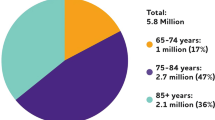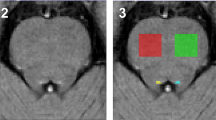Abstract
Alzheimer’s disease (AD) is the most common type of dementia that still has no effective treatment. Accurate classification of AD can help in its diagnosis and selection of the most effective treatment options. In the last decade, several studies have proven the effectiveness of deep learning algorithms for AD diagnosis. In this paper, we propose a U-net style model for AD diagnosis using 3D T1-weighted magnetic resonance images (MRI). Combining with deep supervision has been proved to be effective in improving the performance of the model. Our method has been tested on a subset of ADNI dataset and AIBL dataset and achieves a superior average accuracy of \(95.71\pm 1.36\%\) for AD versus NC (normal control), \(90.14\pm 3.66\%\) for EMCI (early mild cognitive impairment) versus LMCI (late mild cognitive impairment), \(90.05\pm 2.63\%\) for AD versus LMCI, and \(87.98\pm 4.54\%\) for NC versus EMCI, respectively. Besides these binary-classification tasks, we also test this model for multi-class classification task (AD vs. NC vs. EMCI vs. LMCI) and it achieves an accuracy of \(86.47\pm 9.60\%\). Furthermore, 3D-Grad-CAM method is used to visualize the focused areas of the proposed model. We find that the proposed model pays more attention to the characteristics of the ventricles, hippocampus, and some regions of cortex, which have been proven to be affected by AD.







Similar content being viewed by others
References
Minati L, Edginton T, Bruzzone MG, Giaccone G (2009) Reviews: Current concepts in Alzheimer’s disease: a multidisciplinary review. Am J Alzheimer’s Dis Dementias 24(2):95–121
Law AC, Gauthier S, Quirion R (2001) Say no to Alzheimer’s disease: the putative links between nitric oxide and dementia of the Alzheimer’s type. Brain Res Rev 35:73–96
MacGill and Markus (2018) What’s to know about Alzheimer’s disease? https://www.medicalnewstoday.com/articles/159442.php
Association A (2019) 2019 Alzheimer’s disease facts and figures. Alzheimer’s Dementia 15(3):321–387
Cuingnet R, Gerardin E, Jérôme Tessieras G, Auzias SL, Habert M-O, Chupin M, Benali H, Colliot O (2011) Automatic classification of patients with Alzheimer’s disease from structural MRI: a comparison of ten methods using the adni database. NeuroImage 56:766–81
Warsi MA (2012) The fractal nature and functional connectivity of brain function as measured by BOLD MRI in Alzheimer’s disease. Noseworthy Michael D
Garcia-Pedrero A, García-Cervigón AI, Olano JM, García-Hidalgo M, Lillo-Saavedra M, Gonzalo-Martín C, Caetano C, Calderón-Ramírez S (2019) Convolutional neural networks for segmenting xylem vessels in stained cross-sectional images. Neural Comput Appl. https://doi.org/10.1007/s00521-019-04546-6
Wan W, Gao Y, Lee HJ (2019) Transfer deep feature learning for face sketch recognition. Neural Comput Appl 31:9175–9184
Kamalov F (2020) Forecasting significant stock price changes using neural networks. Neural Comput Appl 32:17655–17667
Alpaydin E (2004) Introduction to machine learning (adaptive computation and machine learning). The MIT Press, 0262012111
Ju R, Hu C, Zhou P, Li Q (2019). Early diagnosis of Alzheimer’s disease based on resting-state brain networks and deep learning. IEEE/ACM Trans Comput Biol Bioinform 16: 244–257
Yue L, Gong X, Chen K, Mao M, Li J, Nandi AK, Li M (2018) Auto-detection of Alzheimer’s disease using deep convolutional neural networks. In: 2018 14th international conference on natural computation, fuzzy systems and knowledge discovery (ICNC-FSKD), pp 228–234
Khagi B, Lee CG, Kwon G (2018) Alzheimer’s disease classification from brain MRI based on transfer learning from CNN. In: 2018 11th biomedical engineering international conference (BMEiCON), pp 1–4
Aderghal K, Khvostikov A, Krylov A, Benois-Pineau J, Afdel K, Catheline G (2018) Classification of alzheimer disease on imaging modalities with deep CNNs using cross-modal transfer learning. In: 2018 IEEE 31st international symposium on computer-based medical systems (CBMS), pp 345–350
Khvostikov A, Aderghal K, Benois-Pineau J, Krylov AS, Catheline G (2018) 3D cnn-based classification using smri and MD-DTI images for alzheimer disease studies. CoRR, arXiv:1801.05968
Szegedy C, Liu Wei, Jia Yangqing, Sermanet P, Reed S, Anguelov D, Erhan D, Vanhoucke V, Rabinovich A (2015) Going deeper with convolutions, 2015 IEEE conference on computer vision and pattern recognition (CVPR), pp 1–9
Islam J, Zhang Y (2018) Brain MRI analysis for Alzheimer’s disease diagnosis using an ensemble system of deep convolutional neural networks. Brain Inform 5(2):2
Huang G, Liu Z, van der Maaten L, Weinberger KQ (2017) Densely connected convolutional networks. In: Proceedings of the IEEE conference on computer vision and pattern recognition
Korolev S, Safiullin A, Belyaev M, Dodonova Y (2017) Residual and plain convolutional neural networks for 3d brain MRI classification. In: 2017 IEEE 14th international symposium on biomedical imaging (ISBI 2017), pp 835–838
Ronneberger O, Fischer P, Brox T (2015) U-Net: convolutional networks for biomedical image segmentation. medical image computing and computer-assisted intervention (MICCAI), pp 234–241
Usman M, Wang W, Hadid A (2018) Feature fusion with deep supervision for remote-sensing image scene classification. In: 2018 IEEE 30th international conference on tools with artificial intelligence (ICTAI), pp 249–253
Zhang R, Zhang H, Chung ACS (2018) A unified mammogram analysis method via hybrid deep supervision. CoRR, arXiv:1808.10646
Al-Barazanchi HA, Qassim H, Verma Novel A (2016) CNN architecture with residual learning and deep supervision for large-scale scene image categorization. In: 2016 IEEE 7th annual ubiquitous computing, electronics mobile communication conference (UEMCON), pp 1–7
Xie H, He Y, Lei H, Han T, Yu Z, B. Lei (2018) Deeply supervised residual network for hep-2 cell classification. In: 2018 24th international conference on pattern recognition (ICPR), pp 699–703. IEEE Computer Society, Los Alamitos, CA, USA
Adadi A, Berrada M (2018) Peeking inside the black-box: a survey on explainable artificial intelligence (xai) IEEE Access 6:52138–52160
Yang C, Rangarajan A, Ranka S (2018) Visual explanations from deep 3d convolutional neural networks for Alzheimer’s disease classification. CoRR, arXiv:1803.02544
Rieke J, Eitel F, Weygandt M, Haynes J-D, Ritter K (2018) Visualizing convolutional networks for MRI-based diagnosis of Alzheimer’s disease. CoRR, arXiv:1808.02874
Selvaraju RR, Cogswell M, Das A, Vedantam R, Parikh D, Batra D (2019) Grad-cam: visual explanations from deep networks via gradient-based localization. Int J Comput Vis 128(2):336–359
Ellis K, Bush A, Darby D, Fazio D, Foster J, Hudson P, Lautenschlager N, Lenzo N, Martins R, Masters C, Milner A, Pike K, Rowe C, Savage G, Szoeke C, Taddei K, Villemagne V, Woodward M, Ames D (2009) The Australian imaging, biomarkers and lifestyle (aibl) study of aging: methodology and baseline characteristics of 1112 individuals recruited for a longitudinal study of alzheimer’s disease. Int Psychogeriatrics / IPA 21:672–87
Fischl B, Sereno MI, Dale AM (1999) Cortical surface-based analysis. II: Inflation, flattening, and a surface-based coordinate system. Neuroimage 9(2):195–207
Zhang Y, Wu J, Liu Y, Chen Y, Wu E, Tang X (2020) Mi-unet: multi-inputs unet incorporating brain parcellation for stroke lesion segmentation from t1-weighted magnetic resonance images. IEEE J Biomed Health Inform 25:526–535
Farahani A, Mohseni H (2020) Medical image segmentation using customized u-net with adaptive activation functions. Neural Comput Appl, pp 1–17
Lin Min, Chen Qiang, Yan Shuicheng (2013) Network In Network. arXiv e-prints, arXiv:1312.4400
Chollet F et al (2015) Keras. https://github.com/fchollet/keras
Abadi M, Agarwal A, Barham P et al (2016) Tensorflow: large-scale machine learning on heterogeneous distributed systems. arXiv preprint arXiv:1603.04467
Telagarapu P, Mohanty B, Anandh KR (2018) Analysis of alzheimer condition in t1-weighted mr images using texture features and k-nn classifier. In: 2018 international CET conference on control, communication, and computing (IC4), pp 331–334
Li F, Cheng D, Liu M (2017) Alzheimer’s disease classification based on combination of multi-model convolutional networks. In: IEEE international conference on imaging systems and techniques (IST), pp 1–5
Forouzannezhad P, Abbaspour A, Li C, Cabrerizo M, Adjouadi M (2018) A deep neural network approach for early diagnosis of mild cognitive impairment using multiple features. In: 2018 17th IEEE international conference on machine learning and applications (ICMLA), pp 1341–1346
Cheng D, Liu M (2017) Cnns based multi-modality classification for ad diagnosis. In: 2017 10th international congress on image and signal processing, biomedical engineering and informatics (CISP-BMEI), pp 1–5
Tien DV, Hyung-Jeong YVQ, Nguyen A-RO, Mi-Sun K (2017) Multimodal learning using convolution neural network and sparse autoencoder. In: IEEE international conference on big data and smart computing (BigComp), pp 309–312
Faturrahman M, Wasito I, Hanifah N, Mufidah R (2017) Structural MRI classification for alzheimer’s disease detection using deep belief network. In: 2017 11th international conference on information communication technology and system (ICTS), pp 37–42
Kim J, Lee B (2017) Automated discrimination of dementia spectrum disorders using extreme learning machine and structural t1 MRI features. In: 2017 39th annual international conference of the IEEE engineering in medicine and biology society (EMBC), pp 1990–1993
Liu M, Zhang J, Adeli E, Shen D (2019) Joint classification and regression via deep multi-task multi-channel learning for Alzheimer’s disease diagnosis. IEEE Trans Biomed Eng 66(5):1195–1206
Yang X, Wu Q, Hong D, Zou J (2016) Spatial regularization for neural network and application in alzheimer’s disease classification. In: Future technologies conference (FTC) 831–837
Liu S, Liu S, Cai W, Che H, Pujol S, Kikinis R, Feng D, Fulham MJ, ADNI, (2015) Multimodal neuroimaging feature learning for multiclass diagnosis of Alzheimer’s disease. IEEE Trans Biomed Eng 62(4):1132–1140
Yao D, Calhoun VD, Zening F, Yuhui D, Sui J (2018) An ensemble learning system for a 4-way classification of Alzheimer’s disease and mild cognitive impairment. J Neurosci Methods 302:75–81
Shi J, Zheng X, Li Y, Zhang Q, Ying S (2018) Multimodal neuroimaging feature learning with multimodal stacked deep polynomial networks for diagnosis of Alzheimer’s disease. IEEE J Biomed Health Inform 22(1):173–183
Sorensen L, Nielsen M (2018) Ensemble support vector machine classification of dementia using structural mri and mini-mental state examination. J Neurosci Methods 302:66–74
Juottonen K, Mikko LK, Partanen HS (1999) Comparative MR analysis of the entorhinal cortex and hippocampus in diagnosing Alzheimer disease. Am J Neuroradiol (AJNR) 20:139–44
Qiwu Mu JX, Xie ZYW, Weng YQ, Shuyun A (1999) A quantitative MR study of the hippocampal formation, the amygdala, and the temporal horn of the lateral ventricle in healthy subjects 40 to 90 years of age. Am J Neuroradiol (AJNR) 20:207–211
Sarraf S, DeSouza D, Anderson J, Tofighi G (2016) Deepad: Alzheimer’s disease classification via deep convolutional neural networks using mri and fmri. bioRxiv. https://doi.org/10.1101/070441
Acknowledgements
This work is supported by the National Key R&D Program of China under Grant (2019YFB1311600), Shanghai Science and Technology Committee (STCSM) No 17411953500, 1841195210, and 17511104202. The authors would like to thank the Alzheimer’s Disease Neuroimaging Initiative (ADNI) and the Australian Imaging Biomarkers and Lifestyle flagship study of ageing (AIBL) for providing data for this paper.
Author information
Authors and Affiliations
Corresponding authors
Ethics declarations
Conflict of interest
The authors declare that they have no conflict of interest.
Additional information
Publisher's Note
Springer Nature remains neutral with regard to jurisdictional claims in published maps and institutional affiliations.
Rights and permissions
About this article
Cite this article
Fan, Z., Li, J., Zhang, L. et al. U-net based analysis of MRI for Alzheimer’s disease diagnosis. Neural Comput & Applic 33, 13587–13599 (2021). https://doi.org/10.1007/s00521-021-05983-y
Received:
Accepted:
Published:
Issue Date:
DOI: https://doi.org/10.1007/s00521-021-05983-y




